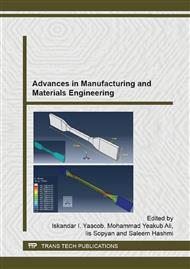p.142
p.146
p.150
p.156
p.160
p.166
p.170
p.174
p.178
Physical and Mechanical Properties of Concrete Incorporating Manufactured Sand
Abstract:
Concrete is a common material that widely used in construction industry. Excessive usage of this material causes exhaustibility to its components, especially fine aggregate or sand. In this regard, the use of manufactured sand is considered as a part of the solutions to fix this problem as it is readily available. In this research, the manufactured sand is used at 40%, 50% and 60% to replace natural river sand. SEM analysis reveals the rough surface texture of manufactured sand. The manufactured sand has angular shape and sieve analysis reveled that it has a considerable amount of fine particle. Slump test shows that concrete using manufactured sand pass the standard. On the other hand, compressive test shows that concrete cubes using manufactured sand do not achieved the target strength. Water absorptive test on the cubes revealed that M-Sand I has higher absorptivity property compared to river sand . SEM analysis revealed the existance of microcrack as well as porosity in in concrete cubes incorporating of manufactured sand. It can be concluded that it can be concluded that the higher the percentage of manufactured sand in the concrete mix the lower is the comprensive strength.
Info:
Periodical:
Pages:
160-165
Citation:
Online since:
July 2015
Authors:
Price:
Сopyright:
© 2015 Trans Tech Publications Ltd. All Rights Reserved
Share:
Citation:


